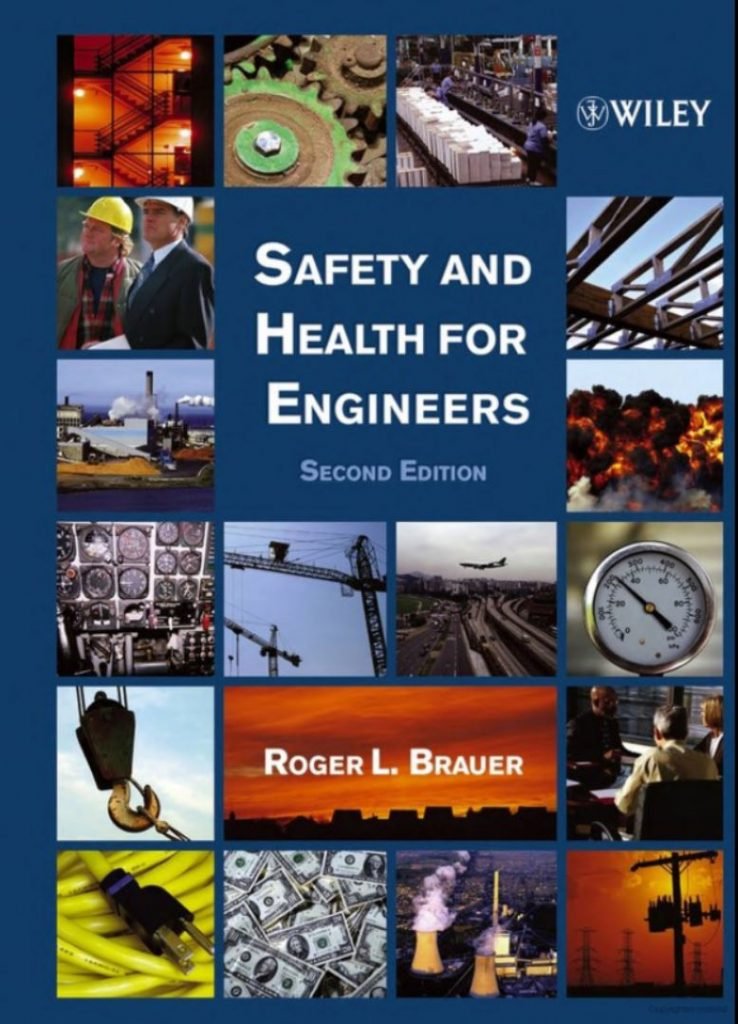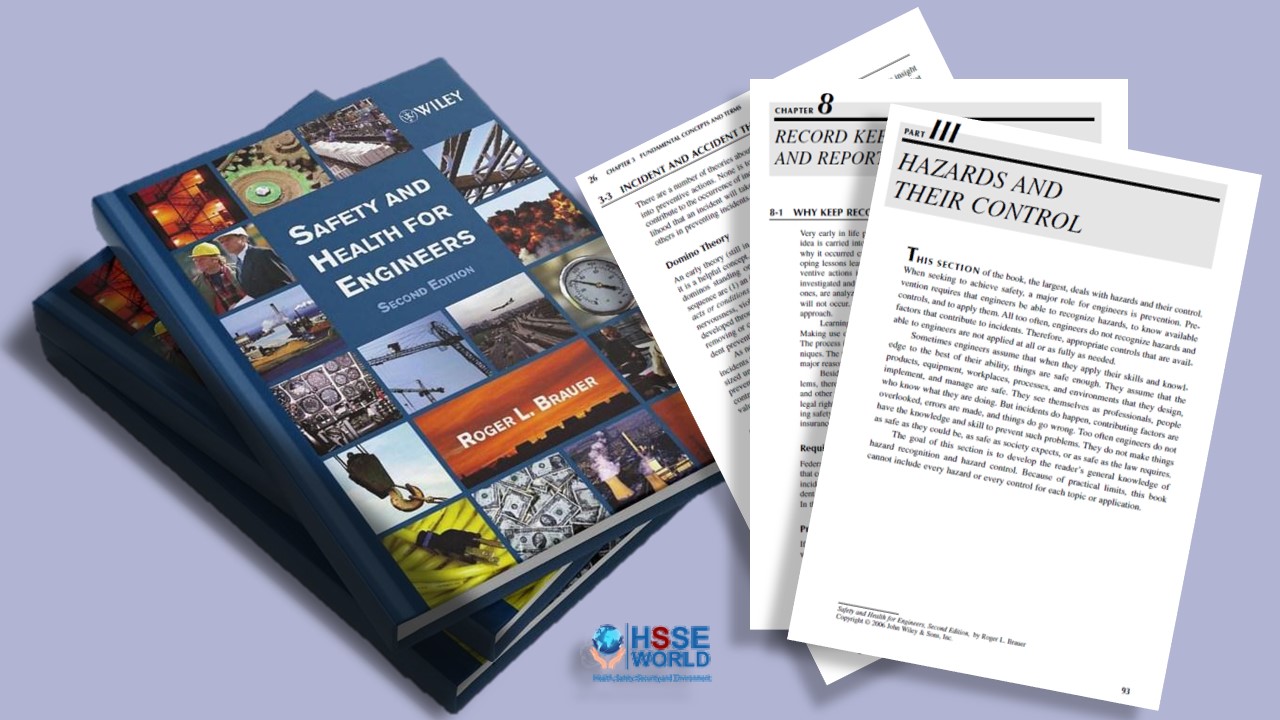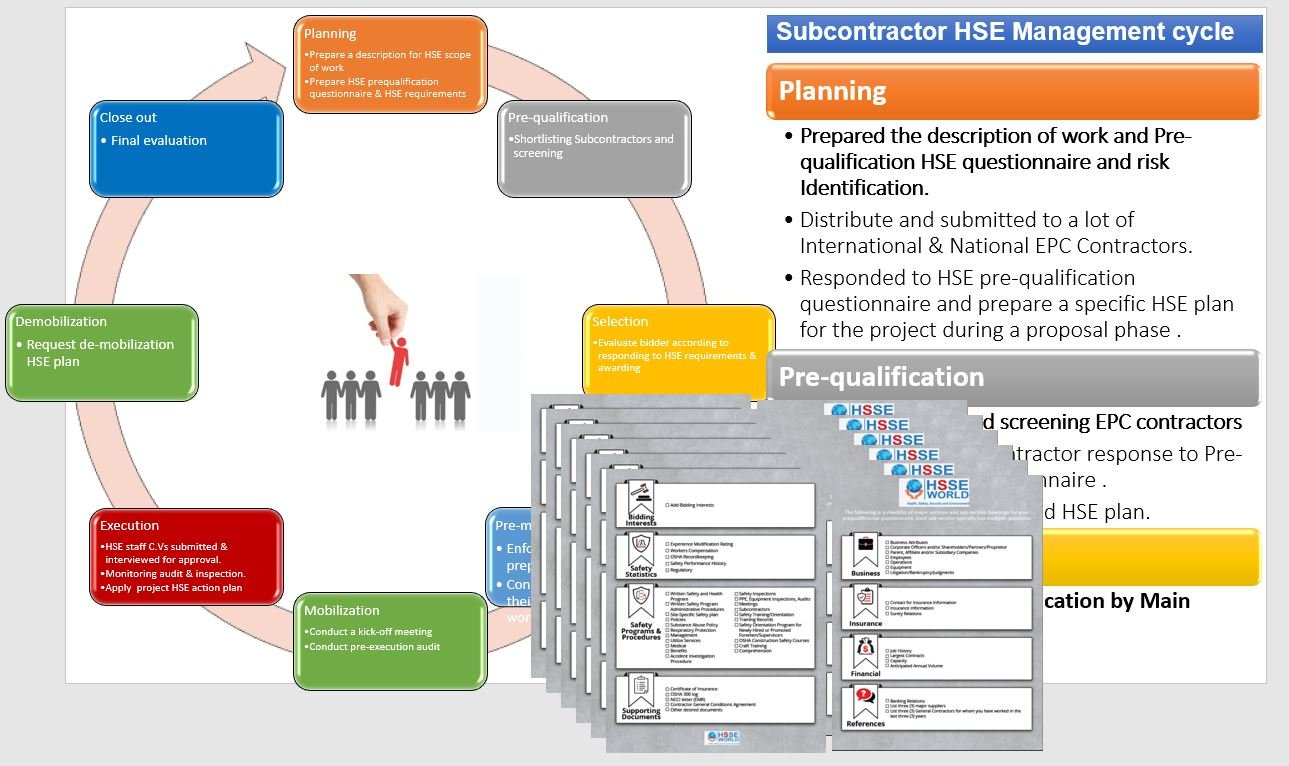Safety and Health for Engineers by Roger Brauer. The original goal for this book was to help engineers and others gain a broad, quick overview of safety and health practices and to identify some of the detailed resources that may provide expanded help with applications.
Since the first edition of this book, some things have not changed and others have. Today, engineers still have a moral, legal, and ethical responsibility to protect the public in professional practice and in the design of products, buildings, processes, equipment, work, and workplaces. The importance of safety in engineering education remains a concern for most engineering degree programs. The need for safety specialists to understand basic technical fundamentals essential in hazard recognition, evaluation, and control continues. As a result, there is still a need for this book. The laws, regulations, standards, and standards of practice in safety and health continue to change on a regular basis. As soon as a book is complete or updated, it is likely to be out of date in certain regulatory areas. The reader should recognize this type of change and consult the government and voluntary standards to ensure compliance with current requirements. Technology continues to change. Computer technology has changed the toolbox for nearly every professional field, and it impacts safety practice as well. Since the first edition was published, the Internet has become an integral part of professional practice, business and business transactions, and many other elements of daily life. Although the explosion in the availability of information continues, one must be able to sort out valid, quality information and reliable information sources from those sources that are not. It is far easier today to find information as well as misinformation on a wide variety of safety issues.

The overall field of safety has changed. One significant trend is the continued growth in the education of those practicing at the professional level. More individuals than ever who specialize in safety have advanced degrees. At the same time, many employers have achieved significant improvements in safety performance by moving safety knowledge and skills deeper into their organizations and workgroups. There seems to be a growing interest among people from other areas of work experience in finding a professional home in the broad safety field. Another trend is the rapid convergence of several related areas of practice. Two decades ago, safety, industrial hygiene, environmental science and engineering, environmental health, ergonomics, fire protection, and other areas of practice often were isolated from each other. Today, many of these have converged into a single organizational unit for an employer, and many individuals regardless of their original backgrounds have responsibility for many of these areas simultaneously. The overall impact is a change in what safety and health specialists do.

The original goal for this book was to help engineers and others gain a broad, quick overview of safety and health practices and to identify some of the detailed resources that may provide expanded help with applications. One of the most valued results of having written this book in the first place is having people who I have never met express appreciation for the assistance it provided them in their professional development. Many have told me that it helped them to understand what safety and health practice is about. It is rewarding to know that a personal project has assisted others professionally.
In completing the update, there are many to thank who may have contributed in some way to the insights offered among the revisions and who pressed me to keep working to complete the revision. I also want to thank my family for their continued support and for tolerating the time often stolen from family activities to make room for the revision effort after abnormally long but typical work weeks.
Contents
Table of Contents of Safety and Health for Engineers
- Fundamental concepts and terms
- Laws, regulations, and standards
- Hazards and their control
- The human element
- Transportation
- Materials handling
- Mechanics and structures
- Explosions and explosives
- Other laws, regulations, standards, and codes
- Noise and vibration
- Product liability
- Ventilation
- Bio-hazards
- Emergencies
- Risk management and assessment
- Safety plans and programs
- Personal protective equipment
Download the book
More Downloads
- E-Books: Healthcare Hazard Control & Safety Management
- E-Books: Safety, Health and Working Conditions Training Manual
- E-Books: Energy Efficiency in Water and Wastewater Facilities
- E-Books: Fire Service Features of Buildings and Fire Protection Systems
- E-Books: Evaluation of Fire Safety free download
- E-Books: PPE for Chemical, Biological, and Radiological Hazards free
- E-Books: Changing the Workplace Safety Culture free download
- E-Books: Site Emergency Planning Workbook
- E-Books: Load Restraint Guide
- E-Books: Essential Practices for Creating, Strengthening, and Sustaining Process Safety Culture
- E-Books: System Safety Engineering and Risk Assessment
- E-Books: Permit-Required Confined Spaces
- E-Books: Is it Safe to Enter Confined Space?
- E-Books: 5-Minute Workplace Safety Talks
- E-Books: Safety Culture and High-Risk Environments
- E-Books: Practical Guide to Industrial Safety
- E-Books: Slip, Trip, and Fall Prevention for Healthcare Workers
- E-Books: Health and Safety at Work Key Terms
- E-Books: Fundamentals of Process Safety Engineering
- E-Books: Gas Detection Hand Book
- E-Books: Occupational health and safety management systems ANSI-AIHA-z10-2012
- E-Books: Hot Work on Drums and Tanks
- E-Books: Human Fatigue Risk Management
- E-Books: Guidelines for the provision of facilities and general safety in the construction industry
- E-Books: Handbook of Training in Mine Rescue and Recovery Operations ( 2021)
- E-Books: Code of Practice for the Safe Use of Lifting Equipment – Edition 9 (Nov 2019)
- E-Books: Free Forklift Health and Safety Best Practices Guideline
- E-Books: Handbook of Hazardous Chemical Properties
- E-Books: Human Performance Improvement through Human Error Prevention
- E-Books: Principles Of Fire Risk Assessment In Buildings
- E-Books: Investigation of Occupational Accidents and Diseases
- E-Books: Radiation Protection and Safety in Industrial Radiography
- E-Books: Basic Guide to System Safety, Third Edition
- E-Books: Food Safety Management-A Practical Guide for the Food Industry
- E-Books: Safety identification: Escape and evacuation plan signs- ISO 23601
- E-Books: Safety at Work
- E-Books: The Safety-Critical Systems Handbook 4th edition
- E-Books: Fundamental principles of occupational health and safety
- E-Books: Fire Safety Risk assessment Guide – Sleeping Accommodation
- E-Books: Mental health at work series
- E-Books: Live Fire Training: Principles and Practice
- E-Books: Pre-Startup Safety Review Guide
- E-Books: Fire and Emergency Drill Manual and Building Inspection Guide
- E-Books: Health and Safety: Risk Management 5th edition
- E-Books: Fire Protection systems -Third edition 2021
- E-Books: Fire Safety Logbook templates
- E-Books: From Accidents to Zero
- E-Books: Electric Safety Practice and Standards
- Your steps to chemical safety
- E-Books: Ergonomics and Psychology Developments in Theory and Practice
- E-Books: HAZOPS Should BE fun-The Stream-Based HAZOP
- E-Books: Safety Health and Environmental Auditing
- E-Books: A Quick Guide to Health and Safety
- E-Books: Occupational Ergonomics A Practical Approach
- E-Books: Job Hazard Analysis A Guide for Voluntary Compliance and Beyond
- E-Books: Electrical Safety of Low Voltage Systems




